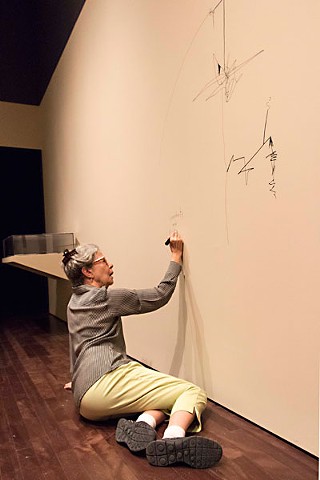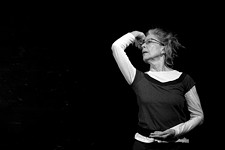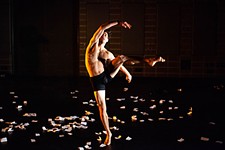That Body, My Teacher
Deborah Hay dances her way into the Blanton to give us a lesson in expanding perception
By Robert Faires, Fri., March 21, 2014
We like our museum art still, don't we?
When a work is simply a static image on a flat surface, be it painting, drawing, or print, we can take it all in at once, and we're free to look at it for just as long as it holds our interest, then move on to another. That's true for sculptures, too, and most installations, around which we might stroll to absorb the fullness of their three-dimensionality, but which we're still obliged to gaze at only long enough to feel we've seen them before moseying along. When the work itself moves, however, as with video, we become conscious of a beginning and an ending and that unspoken need to remain from one to the other, which gets into those messy considerations of time and space, and soon we're not just soaking up art but thinking about those things in relation to it.
That, you should know, is precisely the purpose of "Perception Unfolds: Looking at Deborah Hay's Dance," currently on view at the Blanton Museum of Art, but don't let that keep you away. The intrepid dancer-choreographer at the heart of this exhibition has infiltrated the visual arts realm specifically to help us see the value in pondering that tick-tick-tick of time's passage and our own passage through space. Doing just that has been essential to Hay's practice for decades and has much to do with her international reputation as a pioneer in her field. Hay's method of creating a dance isn't about developing patterns of movement and replicating them in performance after performance; it's about asking questions, positing theoretical situations – "what ifs" – that the dancer contemplates and responds to in the moment. Rather than restrict the dancer to a set series of steps, Hay opens the dancer to multiple possibilities of movement, an endless variety determined by the dancer's individual interpretation of an idea and the myriad factors at play in performance: the site, audience, time of day, dancer's mood .... No performance of any kind, even the most meticulously choreographed and scripted, will ever be exactly the same from one to the next, but performances of Hay's dances always vary wildly due to their very nature, this personal and philosophical approach.
You can see this in A Continuity of Discontinuity, the installation that constitutes the creative side of "Perception Unfolds." Four translucent screens hang in the center of a darkened gallery, with performances by three dancers projected on them. At first, the movements of the three differ so radically that you assume they must be performing different dances. But keep your eyes on them long enough, and you'll eventually see actions or gestures that echo one another: angled arms rising to form a kind of roof over the dancer's head, the body slumping to the floor and lying still. Indeed, these dancers – Ros Warby, Jeanine Durning, and Juliette Mapp – are all performing the same work, a solo by Hay titled No Time to Fly. Each developed her own adaptation of the dance, and these performances – along with many more performances of the solo by these same dancers – were recorded by filmmaker Anna Berger as part of a three-year collaboration between Hay and Motion Bank, an experimental technology research project run by the Forsythe Company in Germany. Collectively, they reveal just how distinctive and diverse the interpretations of a work by Hay can be.
Look at the score for No Time to Fly – and you can in an alcove adjacent to the gallery containing the installation – and you'll get a feel for the kinds of prompts to which Durning, Mapp, and Warby are responding. Here's one: "I sing a wordless song that arises from and combines joy and sorrow into a single melody that resonates through my stilled bones. Barely suppressing a sense of personal history, my face reflects the transience of joy and sorrow." That isn't the sort of action one can execute with any depth of feeling or artfulness without first considering what joy and sorrow are – perhaps in a broad or universal sense but certainly in a personal sense. It's clear from the score and from other comments by Hay (in this illuminating room full of wall texts, videos, and articles related to her work) that Hay thinks a lot and that she wants you to think a lot as well. It's a path to alertness – that sensitivity to every part of your environment and to every part of yourself. Hay has famously described her attempts to be aware of every single cell in her body – all 50 trillion of them! – as a means of expanding her perceptive capabilities and of seeing possibilities in dance as well as life.
That said, as enamored as Hay is of the philosophical question and as useful as she finds it as a spark for movement, she knows that there's a danger in remaining too much in your head. That way lies a focus on technique and mastery when the more productive direction is toward play, that aliveness of the whole body when it engages with its surroundings. In passages here, Hay makes repeated reference to following the lead of her body, allowing it to teach her what to do. So even as she leads you into the work from an intellectual place, Hay asks you to surrender that intellect. Hay wants you to think and not think.
If that sounds like a paradox, well, it is. And that's the trickster in Hay at work – an aspect of the choreographer that's often lost in the shadow of the long-revered trailblazer in contemporary dance. But as Durning says in one of the wall texts, "Deborah likes to pull the rug out from underneath you – you the performer, you the choreographer, you the dancer, you the artist, and you the audience. That's why I gravitate toward her work and keep coming back to it. I never quite know what I'm doing, but know that there is an intelligence in that, not a lack." In one of the two videos included here – the wonderfully titled Turn Your Fucking Head, an excerpt from the hour-long documentary by Becky Edmunds – Hay is shown working with 20 dancers in the final edition of her Solo Performance Commissioning Project. She tells them all to walk like ducks, allowing that she's never been able to walk like a duck without feeeling silly. "Being silly is part of it," she adds. In a wall text, Hay admits that the material in her scores "can be embarrassing to do or idiotic to contemplate, i.e., 'Sing a spontaneous holy song,'" but they're meant, she adds, "to undermine the response mechanism that leads all of us, myself included, to want to get it right."
With that in mind, you can go back to the projected dances and see that the movements in them aren't deliberately alien and opaque gestures, intended to baffle viewers, but the actions of dancers striving to open themselves as fully as they are able to their world, to space and time, to embrace contradictions and release them in movements as deeply felt and considered as possible in the present instant. You'll see how Hay's choreography, in the words of Annette DiMeo Carlozzi, Blanton curator at large and curator of the exhibition, "makes visible the perceptual process, the infinite incremental realizations of movement and response the dancer makes while addressing [her] enigmatic directions."
And once you grasp their approach and watch how it plays out in their movement, it's but a small step to apply it to yourself as you observe them: being aware of your body in relationship to the screens and the bodies on them, to other bodies in the gallery with you, to the floor, the walls, the pillars. Then, as you move, you'll sense the shift in all those spatial relationships and see how everything is connected and yet always fitting together in new and intriguing ways. In "Perception Unfolds," Hay is giving you not only a window into how and why she creates dance but a window into how we all relate to time and space.
Why, you may find thinking about those things not to be so messy after all.
"Perception Unfolds: Looking at Deborah Hay's Dance" is on view through May 18 at the Blanton Museum of Art, 200 E. MLK. For more information: 512/471-7234 or www.blantonmuseum.org.













